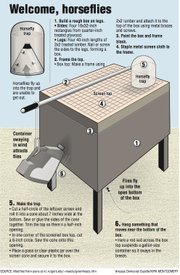The most effective way to kill dozens of horseflies is to use the trap equivalent of the Trojan horse.
The trap doesn’t have soldiers hiding in it, but it does trick the horsefly by resembling its prey and taking advantage of the insect’s hunting habits.
She - yes, the horsefly that bites is a she - flies about 2 feet off the ground, looking for something that might be an animal, and therefore a blood meal.
When horseflies spot a potential victim, they buzz around it, usually ascending. When the buzzing stops, that can mean bad news - the fly has glided in and landed, usually on the back. The victim’s first awareness is the painful lancing of his skin.
Horses swish their long tails, stamp their feet and twitch their skin to shoo away all kinds of flies, but sometimes the horsefly manages to land on a spot the horse can’t get to, like the top of the rump. The horse may run or buck to repel the fly, thus creating a danger for any person on or near the horse. Insect repellents give people and horses some relief, but they do not kill horseflies. Spraying environmentally harmful chemicals in the flies’ breeding areas is not an option.
A horsefly trap uses no chemicals but is lethal. Plans for making various traps are easy to find. Just Google the words “horsefly trap.”
The typical trap is a box or pyramid sitting on 2-foot-tall legs. To keep things simple, let’s focus on the box-type trap. The one described below is based on plans from Rutgers University. (Those plans are found at: rci.rutgers.edu/~insects/greenheads.htm. A greenhead is a horsefly that lives in coastal marshes.)
The bottom of the box is open and the top is covered with screen. In one corner of the screen is an opening covered by a cone of the same screen material. The cone is sewn or glued onto the screen.The tip of the cone is cut off, leaving an opening of about a half-inch.
On top of the cone sits an inverted glass or clear plastic jar with a small opening. The jar is secured so that it doesn’t get knocked over by the wind or rain.
The sides of the box are painted black, which is a good color for attracting horseflies. A ball or plastic jug, suspended by a string on one side below the box, swings in the breeze, creating fly-eye-catching movement.
The fly sees the trap and investigates, flying around it low off the ground. She flies between the legs and moves up. But because there is no horse belly to stop her, she keeps ascending until she hits the screen. She’ll bounce around the screen, looking for a way out, but rarely does she descend out of the box.
When she finds the opening topped by the cone, she continues her ascent inside the cone, popping out of the tip - into the jar. Then she’s trapped. The heat of the sun will kill her in a few hours.
Placement is important, for curious horses will poke their noses through the screen or knock over the trap. The grass underneath and around it should be mowed. The trap can be modified in many ways - such as adding wheels for transport or trying different colors - as long as the basic design stays the same, being open on the bottom and with at least one inescapable vessel for containment on top.
Sometimes other insects find their way into the trap, but in my experience, most of the inmates will be horseflies.
ActiveStyle, Pages 28 on 07/22/2013

